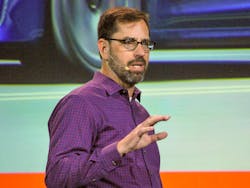How Biogen, Syzygy and Tesla unleash automation
The world is changing more rapidly than ever, and technological innovations are leading the industrial sector into a more productive, efficient and sustainable future. Automation is at the forefront of transformation efforts as companies seek solutions that are simultaneously productive, predictive and prescriptive.
The good news is that process automation technologies are no longer far-flung dreams, but today’s reality. “The technology is here today. The innovation is here today,” said Nina Golder, vice president of lifecycle services for Emerson, who along with Liam Hurley, the company’s vice president, process systems and solutions in North America, welcomed some 1,500 attendees to Emerson Exchange Immerse 2023 this week at the Anaheim Convention Center.
Emerson backed up the claim as a trio of end-users took the stage at the general session of the annual gathering to attest to how process automation technologies are helping to tackle some of industry’s—and the world’s—most pressing problems, such as reducing carbon emissions, scaling electrification and leveraging cloud technologies and AI to create value from data.
Eliminating emissions
Perhaps no issue requires the attention of the process industries, such as oil and gas and chemicals, than mitigating carbon emissions. As climate change data pours in, governments and consumers have taken increased notice of industrialization’s role. The question is, what can be done to turn the tide?
“Eliminating emissions is difficult,” said Trevor Best, CEO of Syzygy Plasmonics, which manufactures all-electric chemical reactors powered by light instead of combustion. “We do not have a modern society without the chemical and energy companies, but they are synonymous with emissions to most people.”
The Pearland, Texas-based company’s technology is based on 30 years of research and development at Rice University. “This is a platform that, by changing out what the nanoparticles are made of, we can adapt it to do many different chemical reactions,” Best said.
Syzygy is developing reactor technology and scaling it for commercial use. Best said that the company has scaled up the reactors at an unprecedented rate and gave credit to Emerson for helping deploy the company’s product, the Rigel reactor, which notably is made of non-exotic steel alloys, glass and aluminum together with nanoparticles of select catalysts. “To start with, it’s being used to generate green hydrogen more efficiently than electrolysis and to take CO2 and put it back into many innovative products,” he continued. The company expects to deploy into the field within the next 12-18 months.
The same Emerson process automation technology that enabled Syzygy’s rapid development from laboratory to commercial scale, Best said, will enable the company to scale the reactor well into the future.
Purpose-driven development
Another response to climate change concerns is the ongoing electrification of many systems formerly powered by fossil fuels. Perhaps no company is more synonymous with such efforts than Tesla, the all-electric vehicle manufacturer made famous by its founder Elon Musk. The company’s leader of advanced innovation, Chuck Fortner, described the targeted efforts the company has taken to pursue its industry-disrupting innovations.
“Innovation doesn’t just happen,” he said. “We always start with a well-defined problem statement and consider the purpose-driven intent behind the products we make.”
Tesla’s well-documented work includes innovations that accelerated the electric vehicle market such as electric-vehicle batteries, self-driving automation and super-charging abilities. “These are all products that are not only transformational in the problems that they solve, but also novel in the way they are made,” he continued.
Fortner, whose expertise is in automation engineering and cell manufacturing, said many of the problems that have always hindered automation engineering during the innovation process, still exist. These include field connectivity, computing capability, network throughput, storage capacity, system security and operational excellence.
The effective use of data is also a hindrance, Fortner said, noting that accelerated value creation based on data is paramount to transformation. The sheer volume of data produced by industry is expanding faster than its ability to adopt effective data analytics software.
Manufacturers generate thousands of petabytes of data every year, but effectively “throw away 99 percent of the data,” according to Fortner. That means most manufacturers are missing an opportunity to create better value from data collection to better be able to efficiently pursue transformational innovation opportunities.
Fortunately, software technology is continually developing to help manufacturers gain actionable insights from data. Tesla, according to Fortner, works with Emerson to look at solutions for modeling and simulation, digital twins, data analytics and machine learning. “What better place to start to solve this problem than with a trusted technology partner like Emerson.” he added.
Mastering the cloud
Implementing data analytics is an issue unto itself. Cloud computing offers a cost-efficient means for collecting and storing valuable data. However, adoption of cloud technologies is often messier than it seems prior to implementation.
Tim Alosi, head of lab IT and data analytics at life sciences leader Biogen, told the Exchange audience that selecting and deploying new cloud technologies can be not only a benefit to companies, but also a burden on their IT and OT service delivery teams. Cloud technology has changed the infrastructure for companies from locally installed software to subscription-based licenses to large-scale software-as-a-service (SaaS) platforms that cover a large swath of their businesses.
“In a perfect world, cloud adoption would be complete and seamless,” Alosi said, “but we end up with a mix of old tech, new tech and everything in between. There are many vendors and multiple components to stitch together to deliver end-to-end solutions and drive benefits.”
The result is dilution of the potential value gained by the technology adoption. Just as Fortner pointed out, companies continue to adopt new technology faster than their skill sets allow for effective use.
“We need to increase our ability to deliver value from the technology,” Alosi added.
To increase value, Biogen developed an integrated system intended to maximize its ability to deliver the right skills for the new software. It also constrained its technology options to further limit the developing skills gaps between legacy technology and new technology. Finally, it sought tricks to help increase the speed to value of the new technology.
One of those tricks was to embrace pre-trained language models of AI. Alosi said Biogen has used them successfully in its cloud strategy. Alosi said vendors such as Emerson are creating solutions to help automatically write code. “How exciting will it be if your automation team can automatically generate some DeltaV code from a process description?” he asked. For its part, Emerson is displaying such technology on the show floor at Emerson Exchange Immerse.
All three speakers stressed how automation solutions from Emerson have helped create better value and scalability for their companies. And as technology continues to accelerate, even more companies will be able to tackle those big innovations that transform the world.
About the Author

Leaders relevant to this article:

